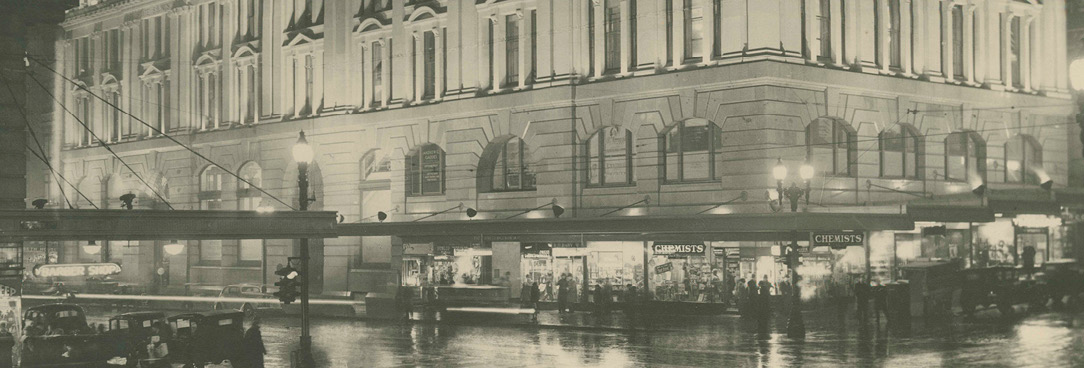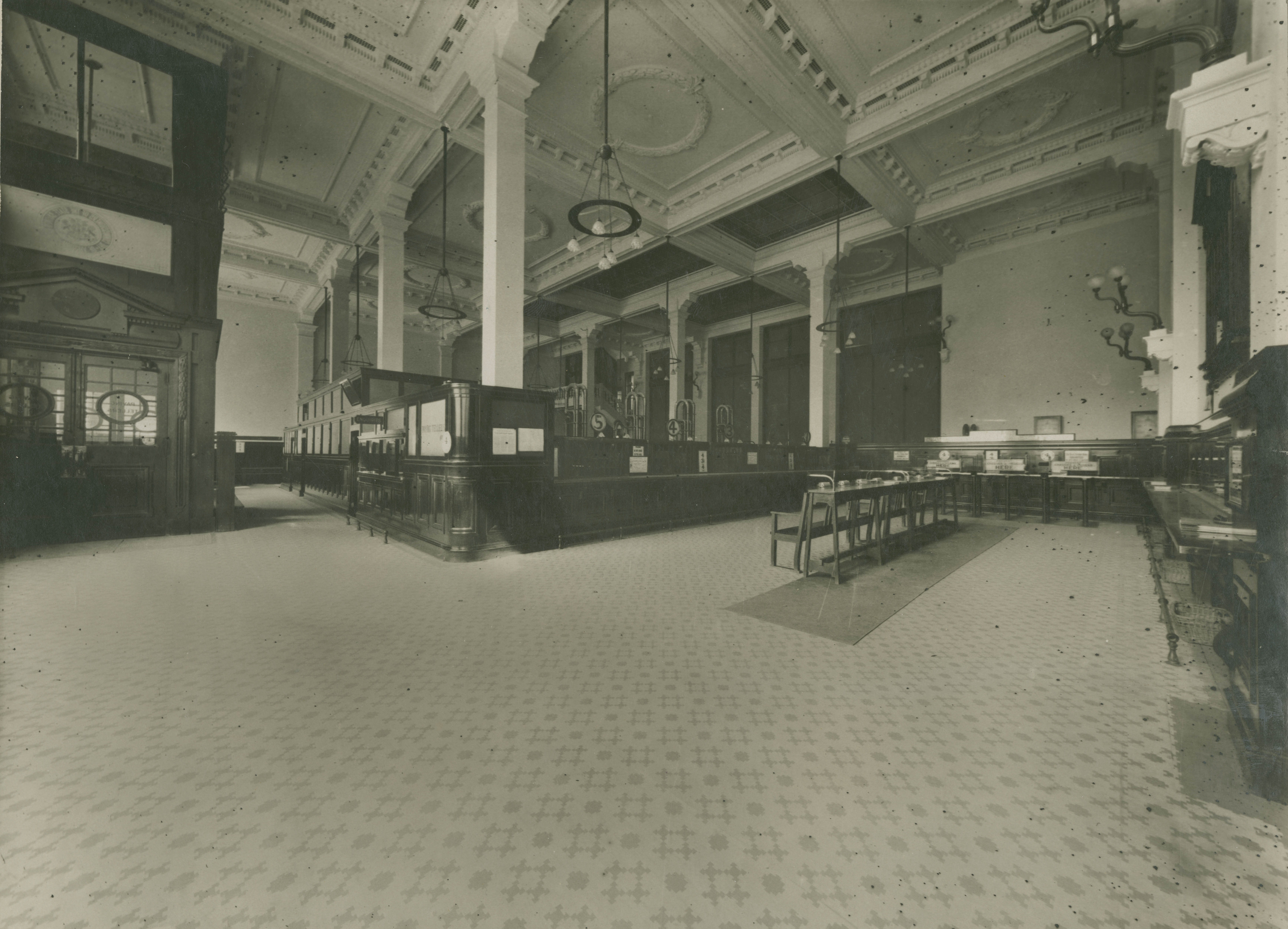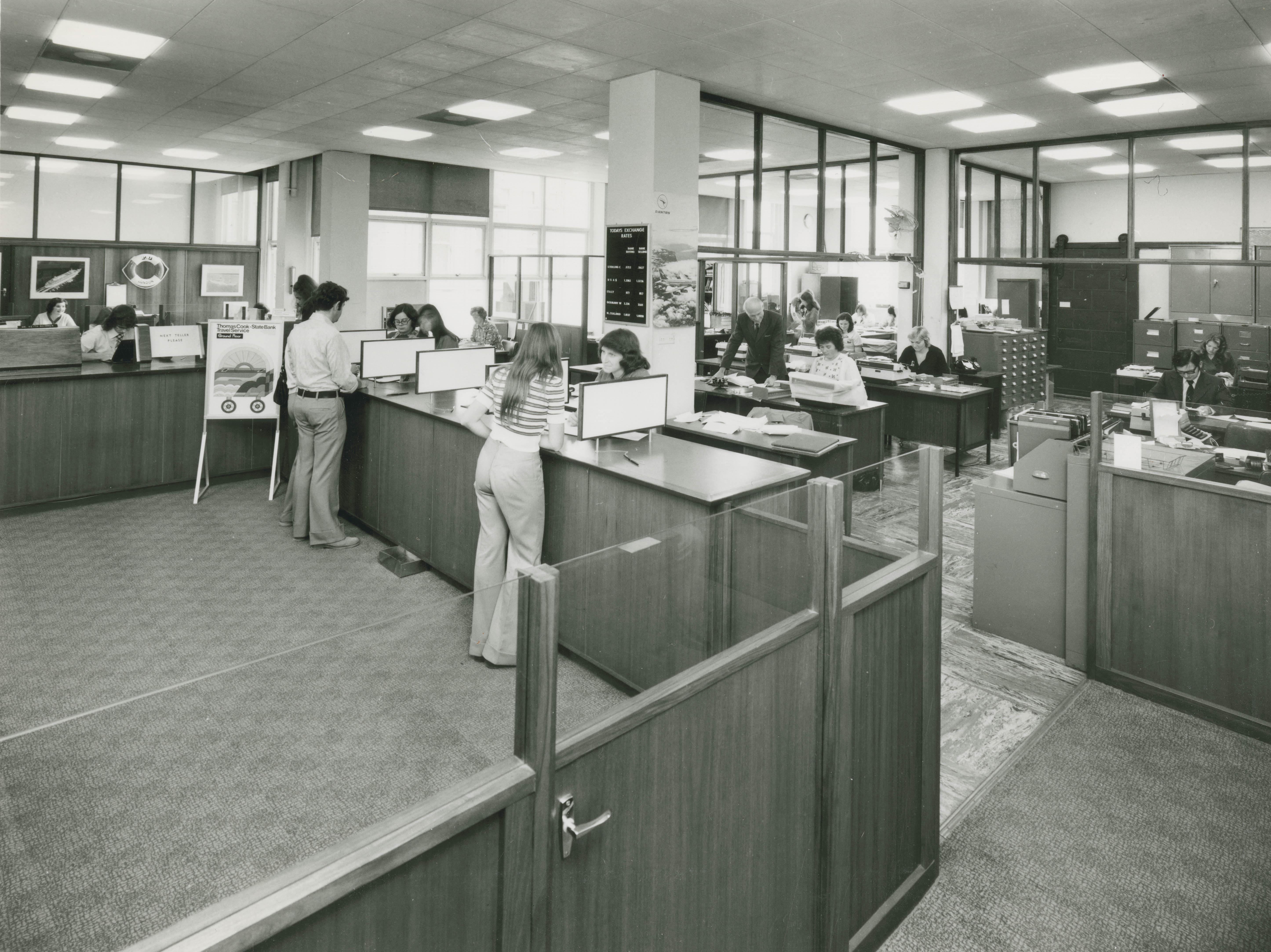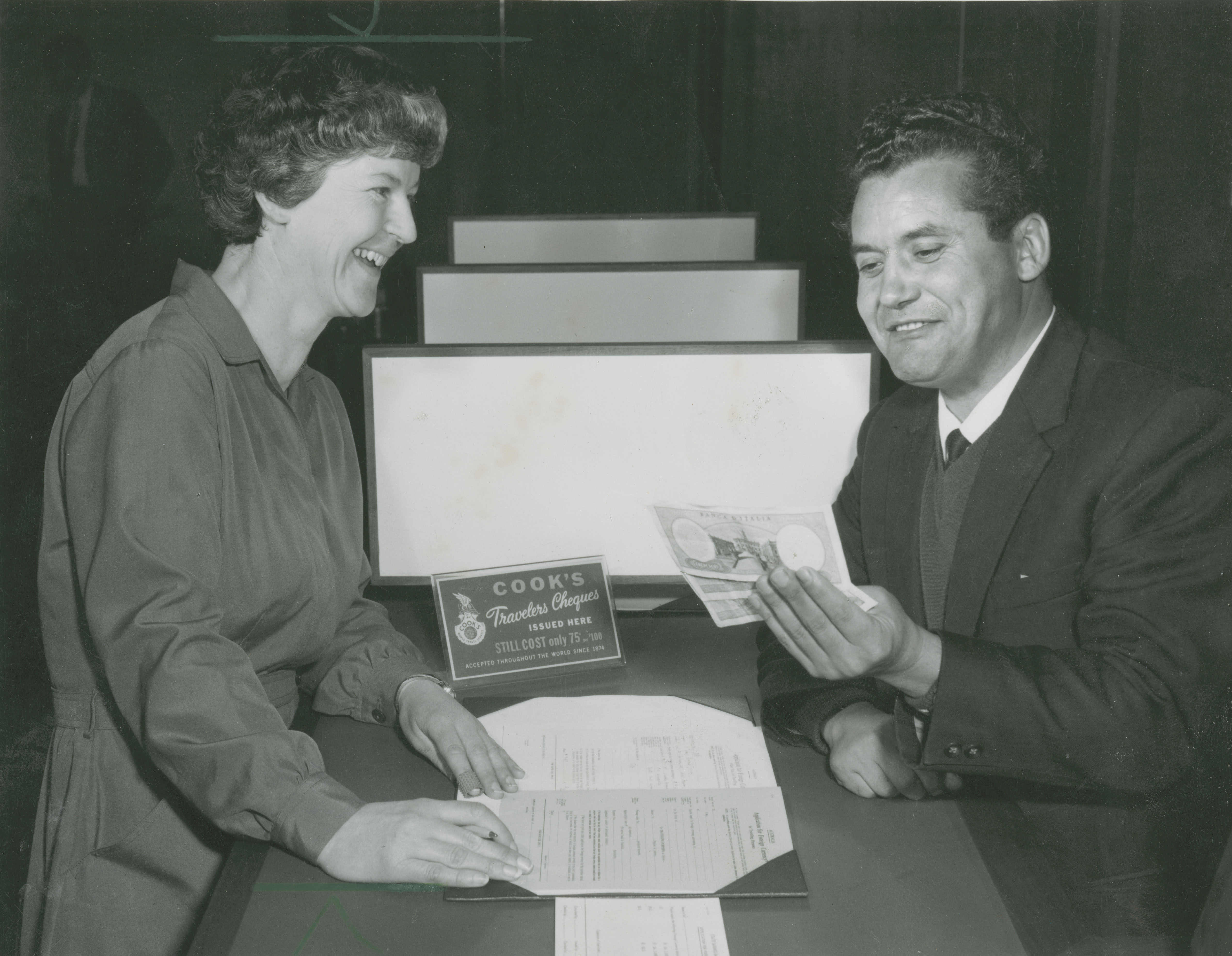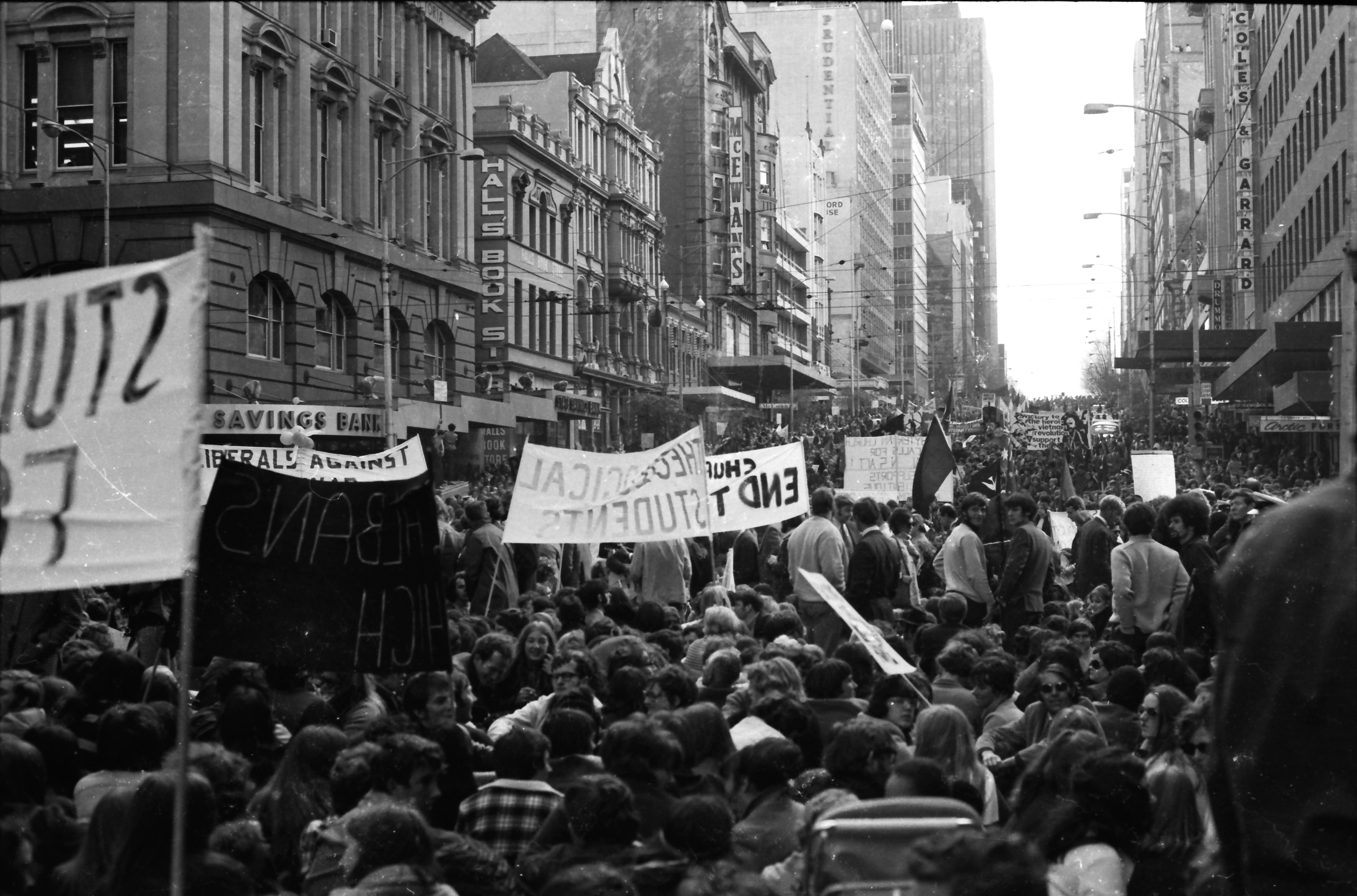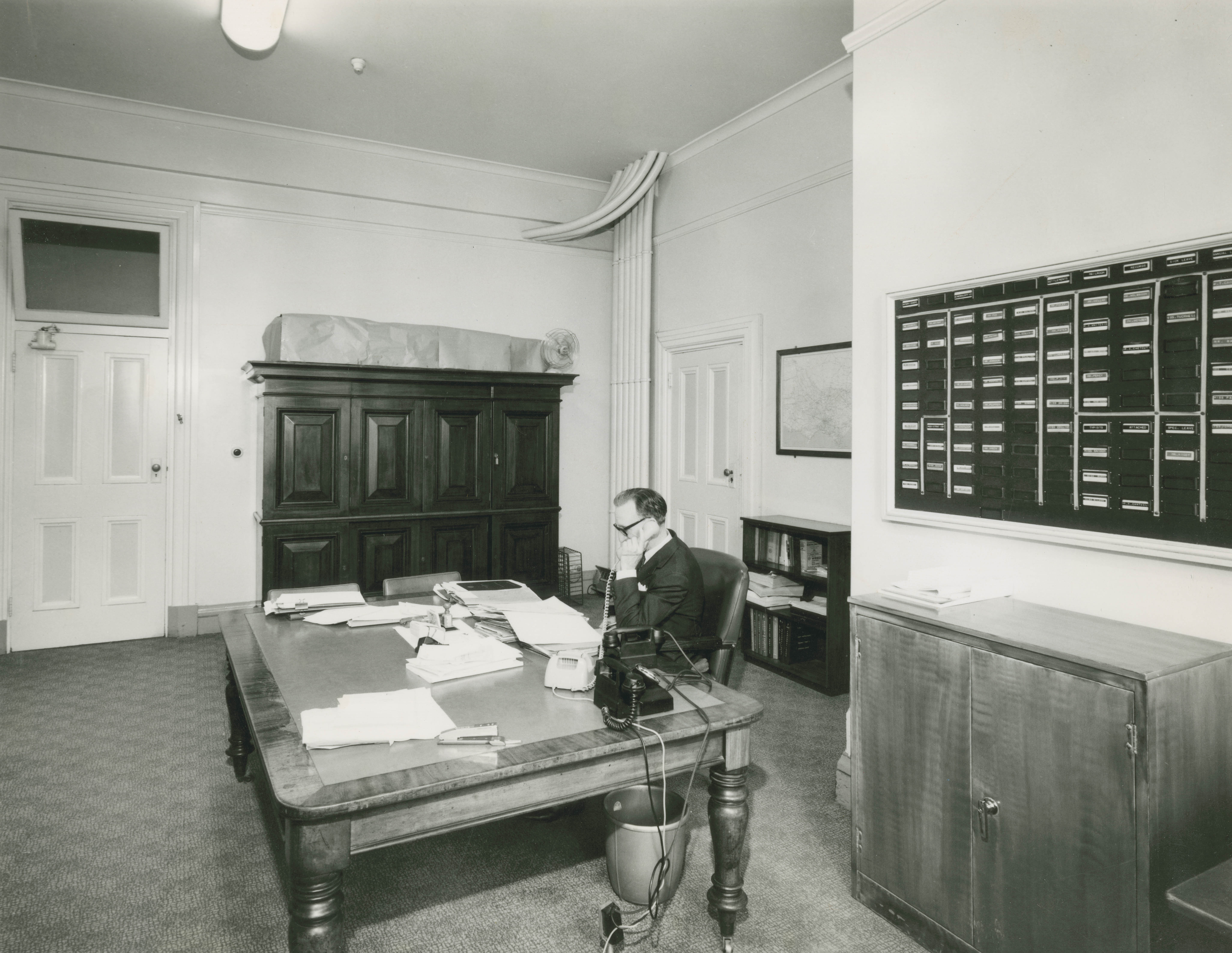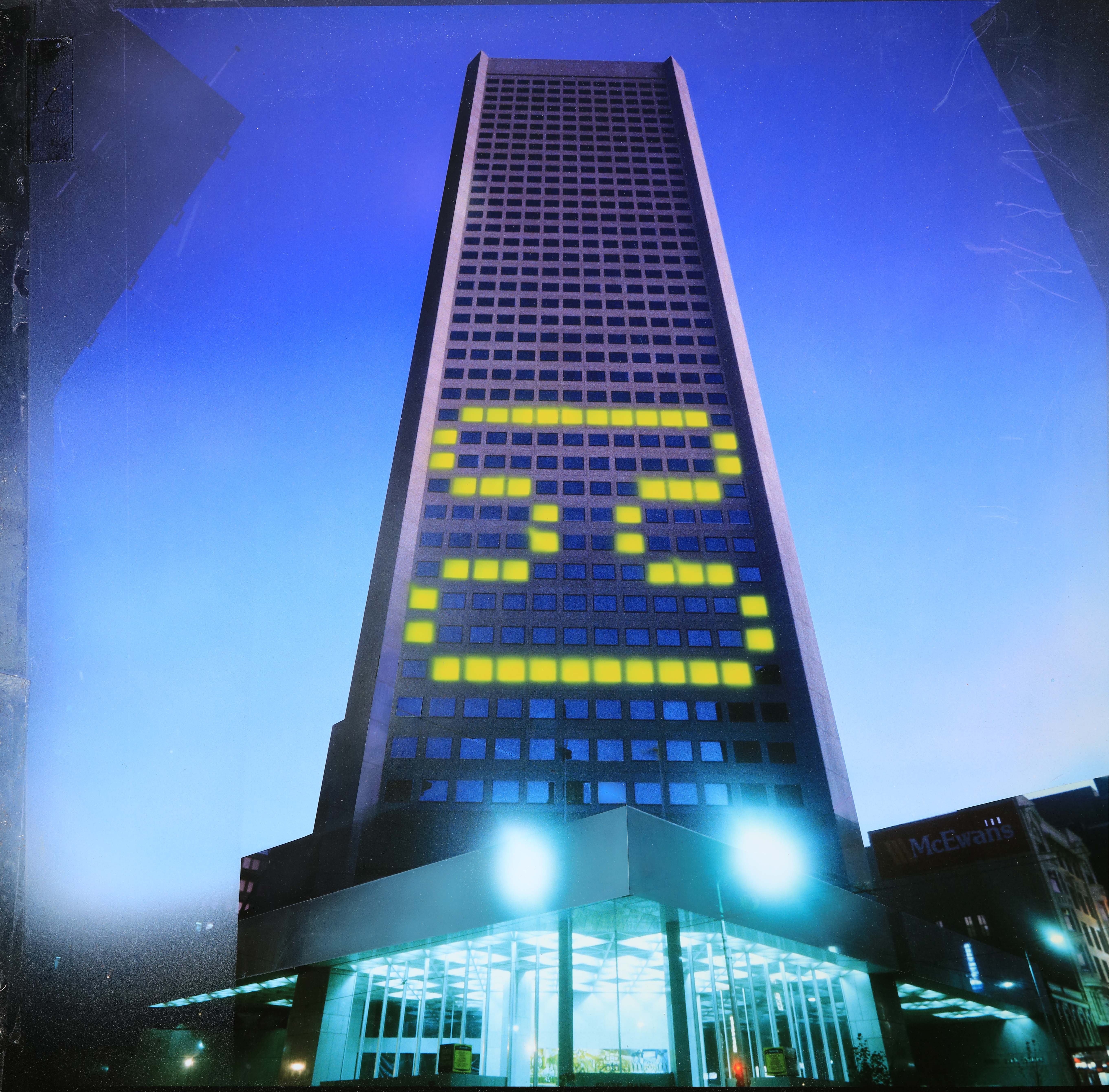Last updated:
'A Visit to Lizzy and Miss Mac: Memories of the State Savings Bank of Victoria Head Office’, Provenance: The Journal of Public Record Office Victoria, issue no. 17, 2019. ISSN 1832-2522. Copyright © Peter Andrew Barrett.
The head office of the State Savings Bank of Victoria was a Melbourne landmark, situated diagonally opposite the General Post Office (GPO) at the intersection of Bourke and Elizabeth streets. Built in stages between 1912 and 1935, the bank’s solid stone façade represented to the community the security of this institution; where the savings of its customers were guaranteed by the bank’s owner, the State Government of Victoria. Through a range of financial services that included mortgage lending, a school banking program, and an extensive network of branches found in almost every suburb and town in Victoria, the State Savings Bank of Victoria had a relationship with most Victorians at some stage in their lives.
The Elizabeth Street head office of the State Savings Bank of Victoria, fondly known by staff as ‘Lizzy’, stood as a silent witness to the day-by-day activity of a city evolving and modernising around it. The demolition of this building in 1975 was a significant loss to the architectural landscape of Melbourne, as well as to the historic and social fabric of the city. The destruction of the building, to redevelop the site with a new headquarters, was a precursor to the eventual demise of the State Savings Bank of Victoria itself, which was sold to the Commonwealth Bank in 1990.
Without a physical presence, the former head office of the State Savings Bank of Victoria is no longer able to speak for the institution it represented, the employees it housed, and the customers it served. In understanding this place, we must now rely upon the memory of people who had contact with it, who over time will, like this building, be gone. In this respect, the vast collection of photographs and architectural plans of this building, held by Public Record Office Victoria, not only prompts the memory of people that knew this place, but provides a valuable narrative to others on the history of this building and its importance in the lives of Victorians.
Our city buildings exude a look and personality of their own. Like people, some are better looking than others; while some emanate more character and charm than others. Some are memorable, and some are best forgotten as soon as they have been encountered. And like people, each has their own story to tell: a story about the institution that they were associated with, the people that they served and accommodated, and the events that they witnessed as the city evolved around them.[1]
State Savings Bank of Victoria Head Office,139 Elizabeth Street, Melbourne. PROV, VPRS 8935/P1 State Bank Victoria Archives – Photographic Collection, Unit 10, Item 1717.
The head office of the State Savings Bank of Victoria was built in stages over three decades. No sooner was one part finished, more room was needed and additional levels added; or a length added to its Elizabeth Street frontage, resulting in its facade eventually extending close to the length of a city block.
Head office banking chamber circa 1912. PROV, VPRS 8935/P1, Unit 10, Item 1698.
With such a piecemeal method of construction, one would think this would lead to an architectural monstrosity, a hotchpotch of elements and parts. Cleverly, the architects added each additional part sympathetically, such that when the last piece of stone was finally added in 1935, it was a seamless architectural composition. The bank was a masterpiece of what is known as the Commercial Palazzo style, that was popular with the banking houses of Australia in the first half of the twentieth century.[2]
State Savings Bank of Victoria Head Office in the 1970s. PROV, VPRS 8935/P1, Unit 3, Item 1486.
*****
As a child, a trip to the city was always scheduled by my mother each school holidays. It was during these visits that my interest in the urban environment was nurtured. This coincided with a period of great change in Melbourne, when, during the 1960s and 70s, much of the human-scale Victorian and Edwardian city was making way for sleek new high-rise buildings. One of my earliest memories is of holding my mother’s hand as we walked along Collins Street in the late 1960s, to the deafening thunder of jack hammers ending another building’s life. It was this sense of loss from the ongoing destruction of my environment that would lead me into the field of heritage conservation.
On our visits to the city, my brother and I would be made to wear our smartest clothes, as we seemed to be on display as much as the stock in the shops and department stores that we visited. Looking our best was especially important if we were to visit my father’s business in Collins Street; or visiting my Aunty Stella, who worked at the head office of the State Savings Bank of Victoria. It was a time when people dressed up when going into town.
Aunty Stella, or ‘Miss Mac’ as she was known in the bank, worked in the Overseas Department on an upper floor of the building. To visit her, my mother, brother and I would enter the building through an arched entrance in Elizabeth Street, and into its banking chamber where customers made their deposits and withdrawals, and conducted other transactions. By this time in the early 1970s, the chamber had been modernised, removing and concealing much of its early ornate decoration and finishes. So high was the ceiling of the banking chamber, that a mezzanine floor had been added a few years earlier to provide additional floor space. Photographs of the banking chamber from around 1912, which are part of the PROV State Bank Victoria Archives Photographic Collection, show its original cavernous and palace-like appearance, with double-floor ceiling height, and marble-finished pillars. This use of stone was symbolic, a subtle reminder to its customers of the financial soundness of this institution.
At one end of the banking chamber were lifts, and a man operating the lift would take us up to the floor of my aunt’s department. In the Overseas Department there was a long counter, where my aunt, a tall figure in her chartreuse-coloured uniform, would appear from a sea of staff seated at rows of desks. On summer days, sun streamed through the large windows of her department, which were open and allowed a gentle breeze through the office. Accompanying this breeze was the noise from the city below, which resonated through the room. This noise, with the activity of all the people in the office and the noise from their typewriters and adding machines, made for chaos of a theatrical quality.
A cafeteria was provided for bank staff on another level of the building, and this we reached by stairs. These stairs were arranged around the lift shafts, with a metal grille providing separation between the two. When using the stairs, a startling effect would occur when a lift-car suddenly swished past the stairwell without warning; no sooner had it appeared, it was gone. Mrs Affleck, the cafeteria ‘manageress’, kept a watchful eye as an army of bank staff were served lunch. When seated, my brother and I would devour a pie-and-chips washed down with Coca Cola, while Aunty Stella and my mother exchanged gossip.
State Bank of Victoria Overseas Department in 1974. PROV, VPRS 8935/P1, Unit 3, Item 1558.
‘Miss Mac’ Stella McDonald of the Overseas Department with a customer. The photograph featured in an article in the bank’s staff magazine Progress in October 1967. PROV, VPRS 8935/P1, Unit 7, item 5819.
State Bank of Victoria staff cafeteria, 1974. PROV, VPRS 8935/P1, Unit 3, Item 1571.
In addition to the openable windows in the various departments and offices of the bank, staff could also get fresh air at lunchtime on the flat roof of the building. After lunch, Aunty Stella would take us to the roof, where we leaned over a steel railing and viewed the busy intersection of Bourke and Elizabeth streets below. If Aunty Stella had timed our rooftop visit well, the clock of the General Post Office (GPO) opposite would strike, temporarily muffling the noise emanating from the streets below. After our rooftop visit, we would bid our aunt farewell, as ‘Miss Mac’ returned to her office and paperwork, and us to the city below.
The roof was a popular place for staff to relax and to get some fresh air. Here, women staff of head office stand on the roof of the bank circa 1940, with the GPO clock visible behind. It is one of many photographs in the State Bank Victoria Archives Photographic Collection taken on the roof of the bank. PROV, VPRS 8935/P1, Unit 9, Item 8555.
*****
Situated in the centre of Melbourne, the head office of the State Savings Bank of Victoria stood witness to sixty years of a city evolving amid historical and social change. The first part of the bank was completed in the years immediately before the commencement of World War I; a war when Australians in large numbers enlisted and served their nation and the Empire. In contrast, sixty years later, it was outside this bank that people questioned our nation’s involvement in war, sitting in their thousands on Bourke Street in the Vietnam War Moratoriums of the early 1970s. It was from the windows of the bank that people observed and reflected upon these momentous days of protest.

Staff photographed on the roof of the head office shortly after the outbreak of World War I. The Union Jack in the background demonstrating the patriotic fervour to the British Empire at this time. PROV, VPRS 8935/P1, Unit 1, Item 8.
Vietnam Moratorium, corner of Elizabeth and Bourke streets, Melbourne, May 1970. The State Savings Bank of Victoria is partially visible at left. Photographer: Bruce Povey. Courtesy Povey Photographs, <http://www.poveyphotos.com>.
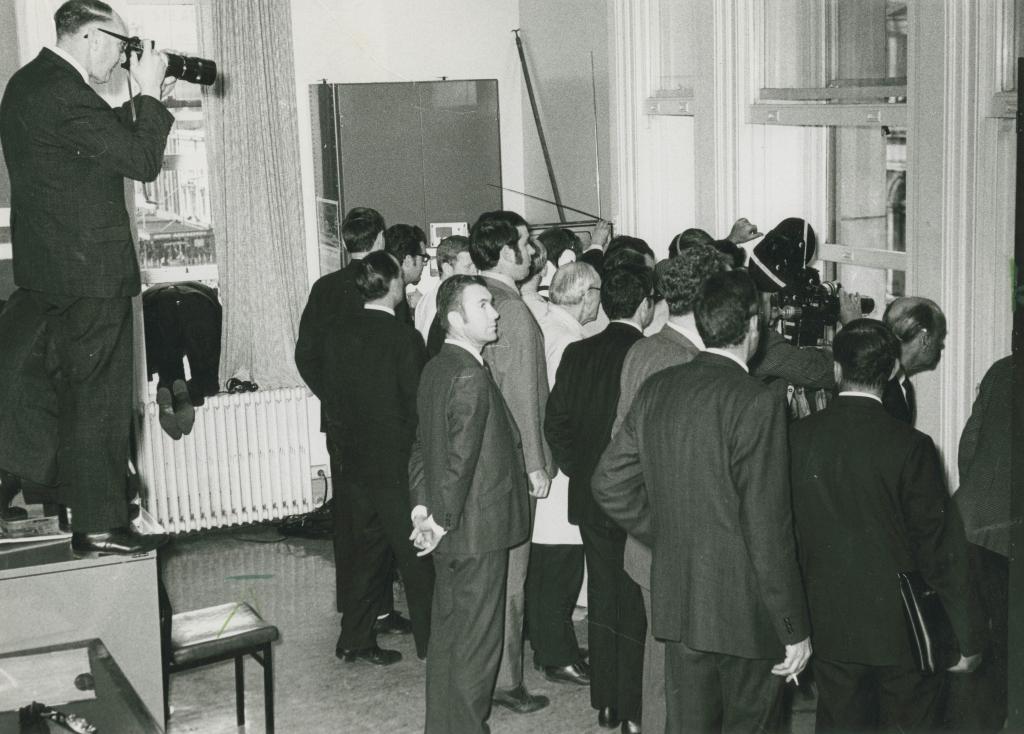
The windows of the bank provided a vantage point for staff and the media to view the Vietnam Moratorium in Bourke Street in May 1970. At left, a man has climbed out on to the ledge on the exterior of the bank for a better view. PROV, VPRS 8935/P1, Unit 7, Item 6310.
Rather than being a casualty of war, it was Modernity that eventually led to the demise of the head office of the State Savings Bank of Victoria. The post-war drive to rebuild Melbourne delivered it to its fate in late 1975, at which time it was demolished to make way for a 41-storey tower that was to become the new head office of the bank.[3] This came at the tail end of a development boom, led initially by insurance and oil companies in the 1960s, and followed by banks, which saw the redevelopment of their sites with striking high-rise buildings. By the early 1970s, new premises had been built, or were underway, for the ANZ, Commonwealth Bank and Bank of New South Wales (now known as Westpac).

Head office staff in the Premises Department at work in 1913. Staffed solely by men, this department featured a spacious and tranquil environment. PROV, VPRS 8935/P1, Unit 3, Item 1439.

Clearing Section of the Accountant’s Department, Head Office, 1971. By the time this photograph was taken, women made up a greater proportion of the staff of various departments, and worked, in contrast to earlier generations, in increasingly cramped conditions at head office. PROV, VPRS 8935/P1, Unit 3, Item 1553.
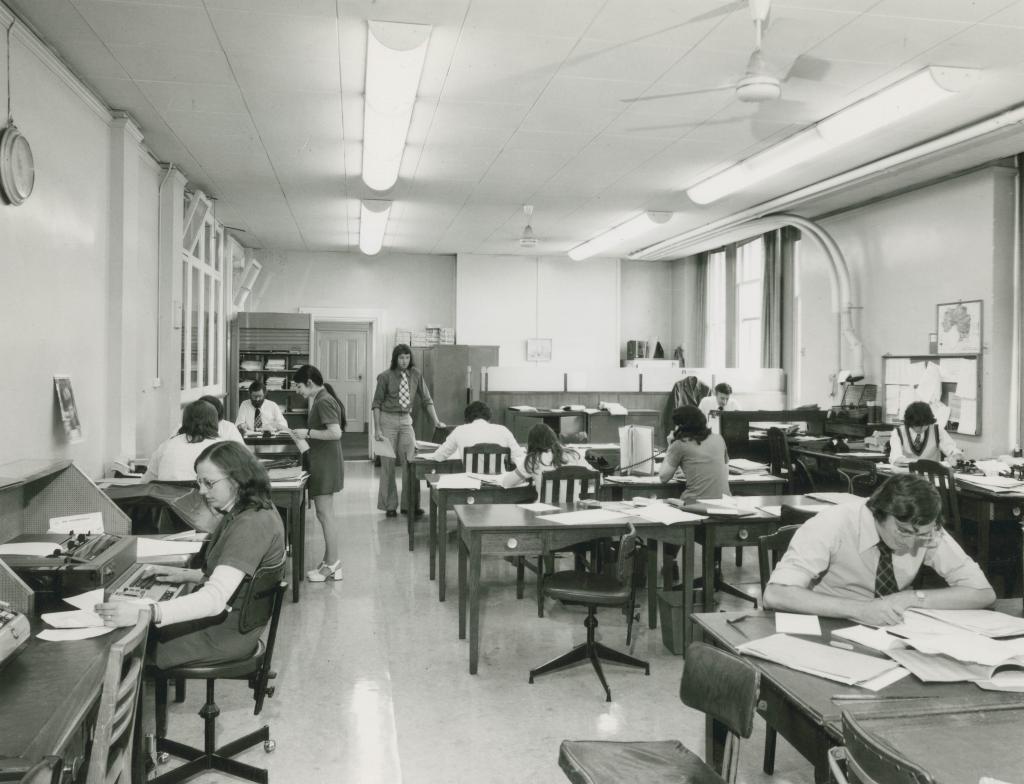
Mortgage Loans General Office, Head Office, 1974. In an era of platform shoes and wide ties, the bank was looking dated and neglected in its final years. PROV, VPRS 8935/P1, Unit 3, Item 1563.
Office of Mr W Anderson, Manager, Mortgage Loans Department, 1974. Many of the offices of head office still retained their original furnishings and fittings at the time of the bank’s demolition. PROV, VPRS 8935/P1, Unit 3, Item 1562.
The purpose of redevelopment of the bank’s site was to maximise the returns from the land it occupied, which was one of the best commercial sites in Melbourne. By annexing neighbouring sites in both Elizabeth and Bourke streets a larger site was formed, and a complex was built that contained the bank headquarters, and also lettable commercial and retail spaces. The rental returns from the new tower and the retail spaces subsidised the cost of the bank’s new headquarters, which was to be known as the State Bank Centre.[4]
The PROV State Bank Victoria Archives Photographic Collection includes photographs showing staff moving from the old bank.[5] The photographs capture the huge scale of the task of vacating the building; shifting files, furniture and office equipment to temporary premises leased during the redevelopment of the site. The photographs are tinged with a mixture of feelings: sadness at the demise of the old place; and humour and camaraderie as staff assist with moving files, office machinery and furniture. Added to this was a sense of optimism with regard to the rebuilding program, with the end result being a brand-spanking new head office befitting a large and modern financial institution.
Unlike the original building, the monolith that replaced it was built in one go; and unlike the old bank, the architects did not assemble all the pieces to fit together to create as equally lovely a composition as the old ‘Lizzy’. Rather, the existing tower sits awkwardly at a diagonal of 45-degrees to the intersection of Bourke and Elizabeth streets; jarring with the polite siting and scale of the GPO and London Stores buildings on opposite corners of the intersection.

The move from the head office in 1975, in preparation of its demolition, was covered in great detail in the bank’s staff magazine Statesman, August 1975, p. 16. Photographs from this article are now part of the State Bank Victoria Archive Photographic Collection held by PROV. The magazine can be accessed at the State Bank of Victoria Social Networking Site, <http://www.statebankvictoria.org>.
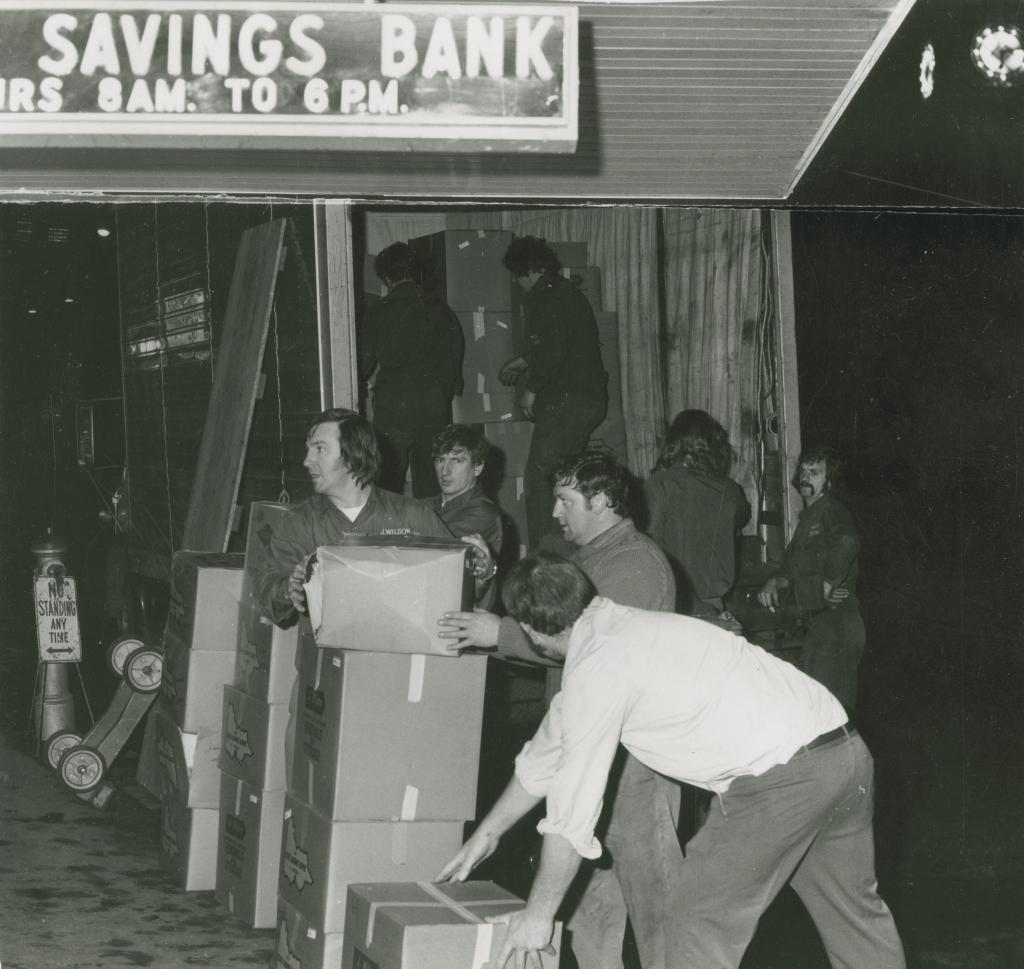
Removalists worked throughout the night shifting the last of the files to be removed from the old head office. The GPO clock is visible at top right, showing the time of this photograph to be 2.30 am. PROV, VPRS 8935/P1, Unit 8, item 6728.
The sale of the State Savings Bank of Victoria to the Commonwealth Bank in the 1990s was described by one newspaper as the ‘passing of a great institution’.[6] Its expansion in the 1970s and 80s, from purely a savings bank to a financial institution that provided a broader range of banking services, had left the bank exposed to a greater level of risk, and this led to its eventual demise. However, it can be said that the passing of this institution occurred long before these events transpired. It occurred when the jack hammers began removing the old head office, which, with its human scale and character, typified the essence of this institution, as a personable financial house – the people’s bank.
The State Bank Centre, corner of Elizabeth and Bourke streets, circa 1980. The State Bank’s ‘hamburger’ style logo of that time has been superimposed onto the tower. PROV, VPRS 8935/P1, Unit 10, Item 8685.
Granted, the 41-storey tower does have hundreds of windows from where expansive views of Melbourne can be appreciated, but unlike the old ‘Lizzy’, the windows are not designed to be opened to let the breeze in on a warm summer day. Nor can you hear the noise of life in busy Elizabeth and Bourke streets below. It was this sensory quality, this connection with the city and its people, that Miss Mac and I missed most about the old ‘Lizzy’.

A view of the State Savings Bank of Victoria Head Office, framed by an arch of the colonnade of the GPO. This photograph was taken in the 1920s, after additional levels were built and the Elizabeth Street frontage extended. In the 1930s, further additions were made to the building, extending its frontage all the way to the corner of Bourke Street. PROV, VPRS 8935/P1, Unit 3, Item 1461.
Endnotes
[1] Public Record Office Victoria, VPRS 8935 State Bank Victoria Archives – Photographic Collection, various units and items as noted in captions of photographs; and book of plans, titled ‘Head Office of the State Savings Bank of Victoria’, dated 1935, in VPRS 8934/P1 State Bank Victoria Archives – Map/Plan Collection, Unit 4.
[2] The first stage of the bank, which opened in 1912, was designed by Grainger and Little architects. The final stage, designed in the 1930s, which extended the bank to Bourke Street, was designed by Stephenson and Meldrum architects. The architect of an intermediate stage, completed in 1926, is not known. ‘Extension to Savings Bank’, Argus, 1 October 1926, p. 9; ‘Savings Bank Buildings’, Argus, 23 November 1933, p. 11; ‘Victorian Savings Bank. New Head Quarters’, Leader, 21 December 1912, p. 18; ‘Opening of the New State Savings Bank, Elizabeth Street, Melbourne’, Punch, 19 December 1912, p. 21.
[3] Designed by Eggleston, McDonald and Secombe architects.
[4] Robert Murray and Kate White, A Bank for the People: A history of the State Bank of Victoria, Hargreen Publishing, North Melbourne, 1992.
[5] State Savings Bank of Victoria, staff magazines Progress and Statesman, various editions, retrieved online from the State Bank of Victoria Social Networking Site, available at <http://www.statebankvictoria.org>, accessed 24 September 2019.
[6] ‘The State Savings Bank: The Passing of a great institution’, Sunday Herald Magazine, 23 September 1990.
Material in the Public Record Office Victoria archival collection contains words and descriptions that reflect attitudes and government policies at different times which may be insensitive and upsetting
Aboriginal and Torres Strait Islander Peoples should be aware the collection and website may contain images, voices and names of deceased persons.
PROV provides advice to researchers wishing to access, publish or re-use records about Aboriginal Peoples
